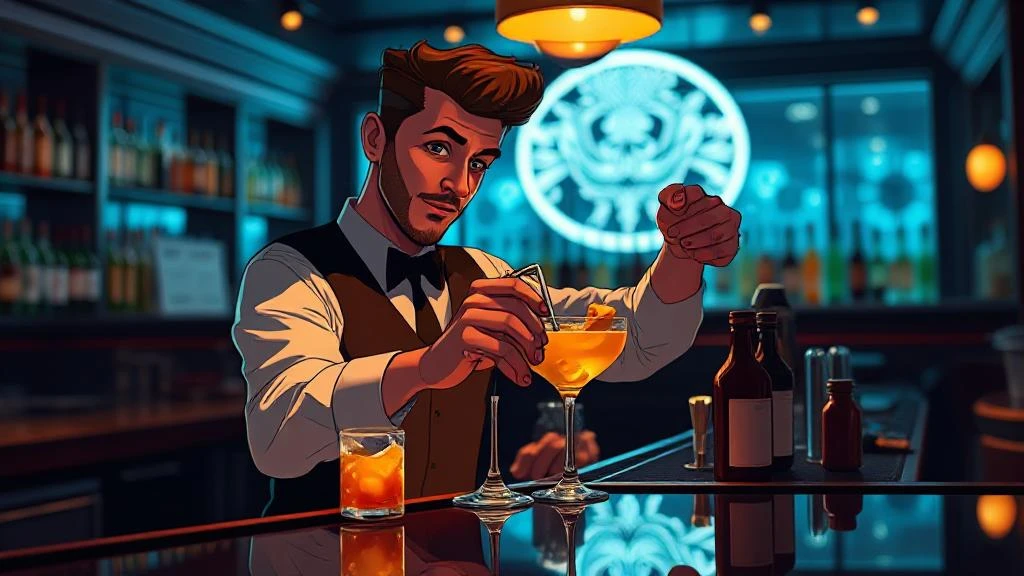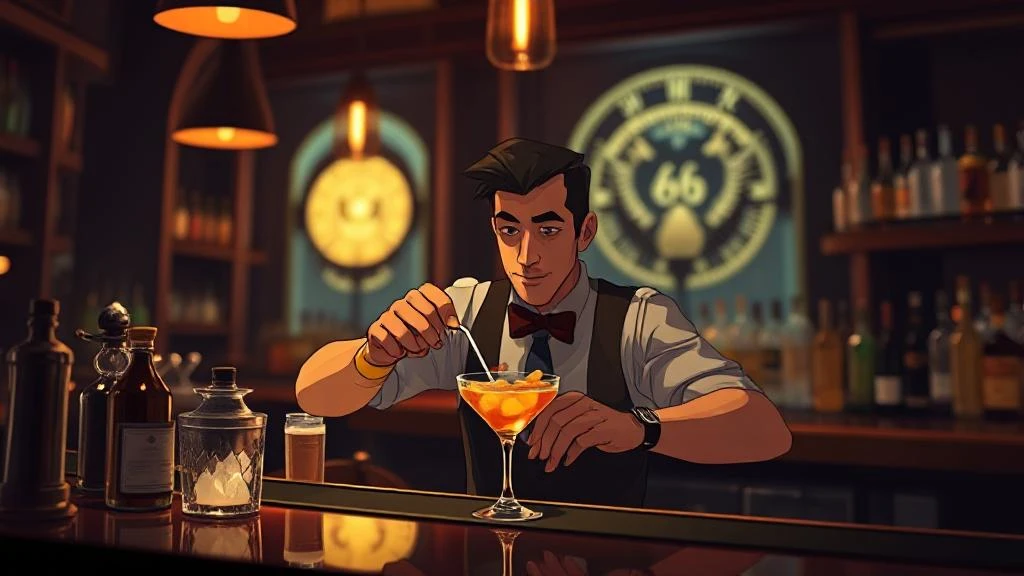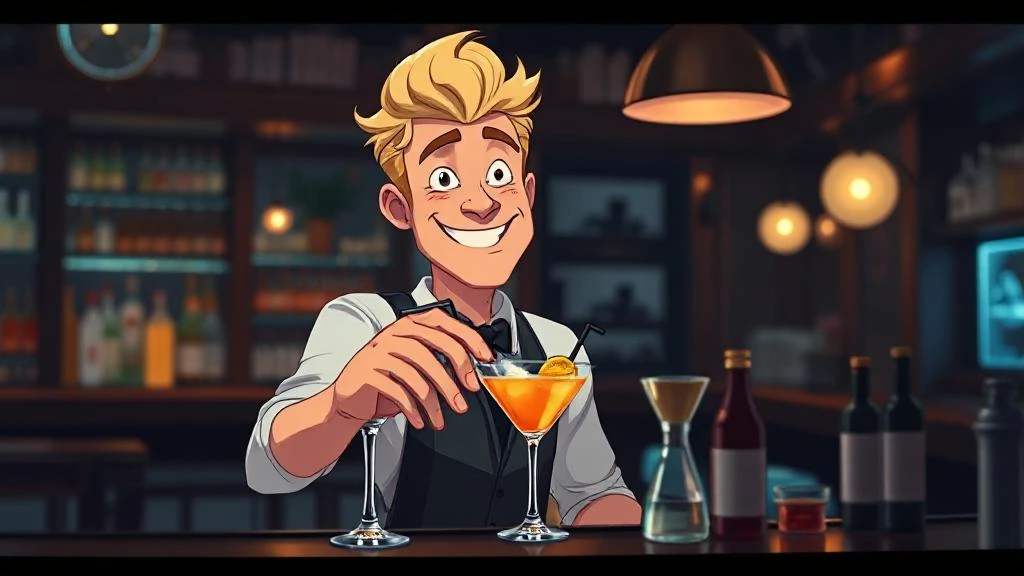Harry MacElhone (1890-1958) was a defining figure in early 20th-century bartending, famous for his bar in Paris, Harry’s New York Bar, his influential cocktail book Harry’s ABC of Mixing Cocktails, and for inventing or first publishing numerous classic cocktails.
his Scottish bartender transformed a simple Parisian bar into a legendary institution that attracted literary giants, movie stars, and cocktail enthusiasts from around the world.
MacElhone’s legacy extends far beyond mixing drinks. He pioneered modern bar marketing, created cocktails that remain standards today, and established the foundations for contemporary mixology culture.
Professional Background & Early Career
Full Name and Origins
Born in Dundee, Scotland, on June 16, 1890, Harry MacElhone was the son of a jute mill owner who would later become one of the most influential bartenders in cocktail history. His journey from Scotland to international fame demonstrates how dedication to craft can transform an entire industry.
Career Foundation
Harry first worked at number 5 Rue Daunou in Paris (the site that he would later acquire and turn into Harry’s Bar) when Milton Henry opened his New York Bar there in 1911. This early exposure to the international bar scene laid the groundwork for his future success.
The young Scotsman didn’t settle immediately. He headed to America, working at the Elton Hotel Bar in Waterbury, Connecticut, and the Plaza Bar, New York, before serving in the air force in World War I. This diverse experience across different continents shaped his understanding of international drinking preferences.
Rise to Prominence
When the war ended, Harry took up a role at Ciro’s Club, London, where he became enough of a celebrity to publish his first book, “Harry of Ciro’s ABC of Mixing Cocktails” in 1921. This position at one of London’s most prestigious establishments marked his transition from bartender to industry authority.
The success at Ciro’s led to expansion opportunities. Harry’s bosses asked him to launch a second Ciro’s, in Deauville, France. These management roles demonstrated his business acumen alongside his bartending skills.
The Birth of Harry’s New York Bar

Acquiring the Legend
In 1923, MacElhone, its former barman, bought the bar and added his name to it. The transformation from “New York Bar” to “Harry’s New York Bar” marked the beginning of a cocktail institution that would influence drinking culture for generations.
The bar’s unique origin story adds to its mystique. The bar was acquired by former American star jockey Tod Sloan in 1911, who converted it from a bistro and renamed it the “New York Bar.” Sloan had gone partners with a New Yorker named Clancy who owned a bar in Manhattan. That bar was dismantled and shipped to Paris.
Creating a Cultural Hub
Under MacElhone’s ownership, the bar became more than a drinking establishment. It began attracting American expatriates and celebrities, including such “Lost Generation” writers as F Scott Fitzgerald, Gertrude Stein and Ernest Hemingway. The bar transformed into a cultural meeting point where art, literature, and mixology intersected.
George Gershwin supposedly wrote “An American In Paris” there, and it has been visited by many movie stars over the years, from Humphrey Bogart to Clint Eastwood. This celebrity patronage elevated the bar’s status from local establishment to international destination.
Mixology Philosophy & Signature Style
Approach to Cocktail Creation
MacElhone’s philosophy centered on balance, quality ingredients, and understanding customer preferences. His approach combined traditional techniques with creative innovation, always prioritizing taste over spectacle.
He believed in documenting and sharing knowledge. MacElhone published a series of cocktail books, in various editions and printings, commonly known as Harry’s ABC of Mixing Cocktails, beginning with Harry of Ciro’s ABC of Mixing Cocktails in 1922, and ending with the twelfth version, the “New Edition” in 1952/53.
Preferred Spirits and Techniques
MacElhone showed particular expertise with gin, cognac, and emerging spirits like vodka. He understood how to balance strong spirits with citrus, liqueurs, and other modifying ingredients to create harmonious cocktails that appealed to sophisticated palates.
His techniques emphasized proper dilution, temperature control, and presentation. Research from Virginia Tech’s cocktail history collection shows that bartenders of the 1920s like MacElhone were instrumental in establishing professional standards that elevated mixology from simple drink preparation to culinary art.
Bar Culture Innovation
Harry founded the ‘club’ in December 1924. He called his bar “Trap No. 1” and his female members “butterflies”. A short, slight man, he gave himself the self-deprecating moniker “Blue Bottle Fly”.
The International Bar Flies club demonstrated MacElhone’s understanding of community building. House rules included: “Members bumping their chin on the rail in the act of falling are suspended for 10 days”; “Those seeing cerise cats with purple ears should keep it to themselves”; and, most famously, “Backslapping after six drinks should be tempered with mercy”.
Signature Cocktail Creations
The White Lady
Ciro’s is also where he began working on his earliest version of the White Lady which included gin, Crème de menthe, Triple sec and lemon juice. MacElhone later refined this recipe, replacing the crème de menthe with gin for a cleaner, more balanced cocktail.
The White Lady represents MacElhone’s evolution as a bartender. The drink showcases his ability to take a good idea and refine it into something exceptional through experimentation and customer feedback.
The French 75
French 75, an effervescent and elegant mix of Champagne, Gin, syrup, and lemon showcases MacElhone’s ability to create celebratory drinks. The addition of champagne elevated a simple gin sour into something special for occasions.
According to research on prohibition-era cocktails, drinks like the French 75 emerged during the 1920s when bartenders sought to create sophisticated alternatives to traditional American cocktails.
The Monkey Gland
Monkey Gland, a bright orange drink made with Gin, orange juice, Absinthe, and Grenadine with a reference to a horrid medical treatment demonstrates MacElhone’s sense of humor and willingness to experiment with unusual flavor combinations.
The cocktail’s provocative name referenced controversial medical procedures of the time, showing how MacElhone connected his bar to contemporary culture and conversation topics.
The Bloody Mary Connection
The Bloody Mary‘s origin story remains contentious, but Harry’s New York Bar plays a central role. The French bartender Fernand Petiot claimed to have invented the Bloody Mary in 1921, well before any of the later claims, according to his granddaughter. He was working at the New York Bar in Paris at the time, which later became Harry’s New York Bar.
While Petiot may have created the original vodka and tomato juice combination, MacElhone’s establishment provided the environment where this iconic cocktail could develop and gain international recognition.
Industry Contributions & Legacy
Literary Contributions
MacElhone’s books became essential references for bartenders worldwide. These books were very popular, feature the earliest known recipes of many important drinks, and provide a record of cocktail culture as it spread internationally in the interwar period, during and immediately after Prohibition.
His 1927 work, “Barflies and Cocktails,” went beyond recipes. Barflies and Cocktails had illustrations, a different publisher, and supplement about the bar’s customers and their favored drinks, but the same main list of cocktails. This approach influenced how bartenders thought about customer service and bar atmosphere.
Marketing Innovation
McElhone is credited or partially-credited with creating and/or popularizing many well-known cocktails, and is the de facto inventor of modern bar marketing. His promotional strategies included branded merchandise, customer clubs, and strategic celebrity relationships.
McElhone produced vast quantities of merchandise promoting his bar (including the aforementioned books) and achieved great success making Harry’s a popular destination. This comprehensive approach to bar promotion became a template for successful establishments worldwide.
Educational Impact
MacElhone influenced bartending education through his systematic approach to recipe documentation and technique instruction. Studies of professional bartending development show that his methodical recording of recipes helped establish standardized cocktail preparation methods that persist today.
Industry Relationships & Influences
Contemporary Bartenders
MacElhone worked alongside and influenced many prominent bartenders of his era. As a respected friend of other leading bartenders of his day, it was Harry who was invited behind the stick of the Paris Ritz when Frank Meier headed out for a stint at the New York Ritz.
His relationships with figures like Frank Meier and Harry Craddock created a network of influential bartenders who shared techniques and elevated the profession’s standards across Europe and America.
Wartime Resilience
After German troops appeared in Paris in 1940, Harry bricked up his booze in the cellar and took refuge in London, where he and his son Andrew worked at the Café De Paris. This dedication to preserving his establishment during wartime demonstrates his commitment to the craft and business.
Harry was there on the night a direct hit from a German bomb destroyed the place, and – according to his family – went on to work at the London Ritz. His resilience during this traumatic period showed how deeply bartending was embedded in his identity.
Continuing Family Legacy
When Harry died, in 1958, his son Andrew took over the bar and ran it until 1989. His son, Duncan, took over the bar and ran it until his death in 1998, when his widow, Isabelle MacElhone, took it over.
The current generation continues the tradition. Franz-Arthur MacElhone, fourth generation running Harry’s Bar, 1911, the oldest cocktail bar in Europe maintains his great-grandfather’s commitment to quality and tradition while adapting to modern tastes.
Cultural Impact & Recognition
Literary References
In the book Casino Royale, Ian Fleming’s character Bond said it the best place in Paris to get a “solid drink.” This endorsement from one of literature’s most famous characters cemented the bar’s reputation for quality cocktails.
The bar’s influence on popular culture extends beyond literature to film, music, and art. Its role as a gathering place for creative minds made it a symbol of sophisticated nightlife and international culture.
Political Engagement
Harry’s conducts a straw poll before each US presidential election. Customers who provide proof of US citizenship can vote in the poll. The results have mirrored every election, except 1976, 2004, and 2016 since the poll began in 1924.
This tradition, started by MacElhone, demonstrates how the bar served as more than an entertainment venue—it became a forum for international political engagement and cultural exchange.
Modern Recognition
As of 2022, his descendants continued to run Harry’s New York Bar. The bar’s continuous operation under family management speaks to MacElhone’s success in creating not just a business, but an institution.
Research on cocktail culture’s global influence shows that establishments like Harry’s New York Bar helped spread American cocktail culture internationally while maintaining distinctive local character.
Contact & Legacy Information
Visiting Harry’s New York Bar
Harry’s New York Bar continues operating at its original location: 5 Rue Daunou, Paris, France. The establishment maintains MacElhone’s commitment to quality cocktails while adapting to contemporary tastes and expectations.
Current Management
Franz-Arthur MacElhone maintains the family tradition while bringing modern perspectives to the historic establishment. The current generation balances respect for tradition with necessary evolution in hospitality and mixology.
Historical Preservation
The bar serves as a living museum of cocktail culture, preserving MacElhone’s recipes, techniques, and atmosphere for new generations of bartenders and cocktail enthusiasts to study and appreciate.
Harry MacElhone’s influence on modern cocktail culture cannot be overstated. From his Scottish origins to his Parisian success, he demonstrated how passion, skill, and business acumen could transform bartending from service work into artistic profession. His cocktails remain standards, his bar continues thriving, and his approach to hospitality and marketing continues influencing establishments worldwide.
MacElhone proved that great bartenders don’t just make drinks—they create experiences, build communities, and preserve culture for future generations. His legacy lives on in every perfectly balanced cocktail and every bar that prioritizes both quality and hospitality.











